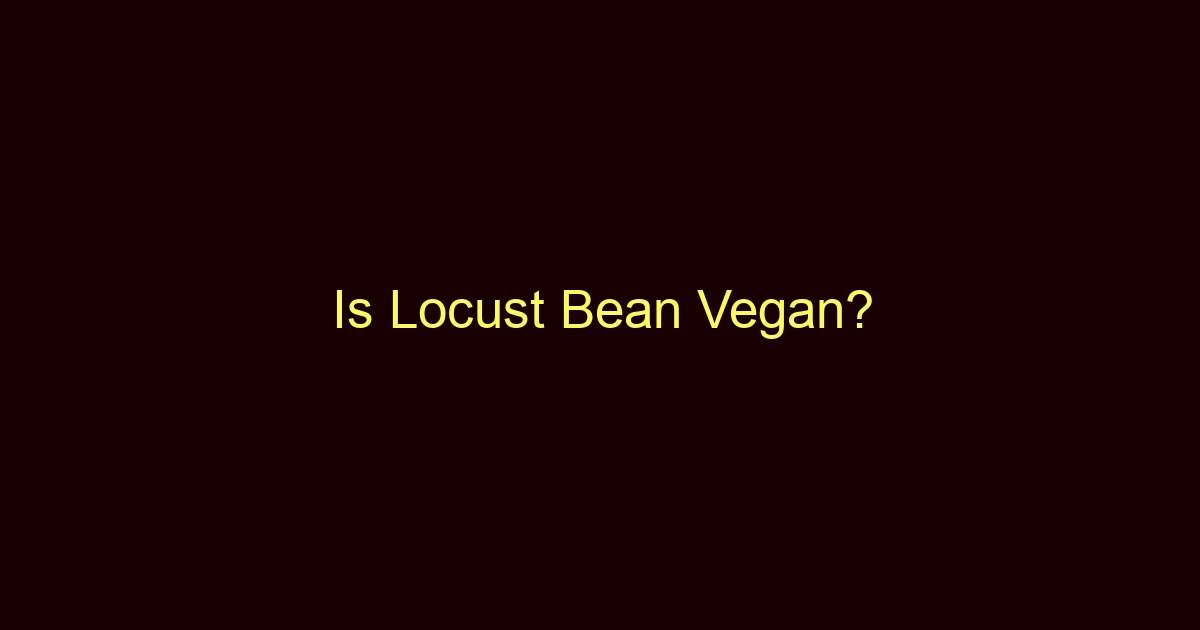Locust bean, also known as carob, is a Mediterranean plant with a wide array of culinary and industrial uses. But have you ever pondered if this versatile bean is compatible with a vegan lifestyle? Let’s dive into this topic and explore the nature of the locust bean.
What is Locust Bean?
Locust Bean or carob tree, scientifically named Ceratonia siliqua, is a leguminous evergreen tree that is native to the Mediterranean region. Known for its resistance to arid conditions, the locust bean tree produces a fruit in the form of a pod. The pod contains sweet pulp and seeds, both of which are utilitarian in various industries.
Locust beans have been a part of human diets for thousands of years, and they remain a valuable source of nutrition and health benefits. The beans are also gaining increasing recognition in modern cooking and health food industries. Why? Well, that brings us to what the locust bean is made of.
What is Locust Bean Made Of?
Locust bean is composed of the carob fruit which includes the pod and the seeds. The pulp of the pod is sweet and edible. It is rich in sugars, mainly sucrose, glucose, and fructose. Moreover, it contains fibers, tannins, and proteins. Carob pulp is often dried and ground into carob powder, which is used as a cocoa substitute.
The seeds inside the pods contain a type of polysaccharide (long-chain carbohydrate) called galactomannan. This substance is extracted to create locust bean gum, a food additive used as a thickening and stabilizing agent in a variety of food products. It’s a vital ingredient in the food industry.
What is Locust Bean Used For?
The use of locust bean spans across several industries. In the culinary world, carob powder, derived from the dried pulp, is a favored cocoa substitute in baking. It’s naturally sweet, low in fat, caffeine-free, and can be used to make cakes, cookies, and even ‘chocolate’ bars.
Locust bean gum, on the other hand, extracted from the seeds, is used as a stabilizer and thickener in foods like ice cream, yogurt, and salad dressings. It’s also used in the textile industry for printing and in the cosmetic industry as a thickener in products such as lotions and creams.
What Foods Contain Locust Bean?
Locust bean can be found in various forms in many food products. As a cocoa substitute, you’ll find it in a variety of baked goods, confectionery, and beverages. As locust bean gum, it’s used in dairy products like ice cream and yogurt, sauces, dressings, canned foods, and even in certain types of cheese.
Is Locust Bean Vegan?
Yes, locust bean is vegan. It is derived from the carob tree, making it a plant-based ingredient. The extraction process of both carob powder and locust bean gum does not involve the use of any animal products or byproducts. So, whether you’re enjoying a cake made with carob powder or an ice cream stabilized with locust bean gum, you can be assured that these ingredients are vegan-friendly.
Can Vegans Eat Locust Bean and Why?
Vegans can definitely eat locust bean. Its plant origin and processing methods are in accordance with vegan guidelines. Furthermore, locust beans offer a variety of nutrients including dietary fiber, antioxidants, and minerals, making them a beneficial addition to any diet, vegan or otherwise. However, as with any food, it’s recommended to consume it as part of a balanced diet.
Benefits of Locust Bean
The locust bean, or carob, provides a wealth of benefits. Carob is rich in fiber, which aids in digestion and helps maintain a healthy gut. It also contains antioxidants which help to protect against free radicals and oxidative stress.
Furthermore, carob is low in fat and sodium and is naturally sweet, meaning it requires less added sugar when used in baking. It’s also caffeine-free and contains fewer allergens than cocoa, making it a good alternative for those with allergies or sensitivities.
Possible Downsides of Locust Bean
While locust bean is generally safe for consumption, some people might experience negative effects. In certain individuals, locust bean gum may cause digestive issues such as bloating, gas, and stomach cramps. People with legume allergies may also react to carob.
Locust Bean in a Balanced Diet
In a balanced diet, locust bean can be a nutritious addition. Carob powder can be used to replace cocoa in baked goods, offering a lower fat and caffeine-free alternative. Locust bean gum, while it doesn’t offer much nutritional value, is a versatile thickener and stabilizer with a very low calorie count.
However, it’s important to remember that locust bean products are often used in processed foods, which should be consumed in moderation as part of a balanced diet rich in whole, unprocessed foods.
Is Locust Bean Safe?
Locust bean is safe for the general population, including those following vegan, gluten-free, or allergen-free diets. It’s widely used in the food industry and generally well-tolerated. However, as with all foods, it’s recommended to consume in moderation and to be aware of any potential food sensitivities or allergies.
Final Thoughts
To sum up, locust bean is vegan-friendly and a versatile ingredient. It provides a wealth of dietary benefits, especially in its carob powder form. Furthermore, its derivative, locust bean gum, is widely used as a food additive across various industries. While it’s a plant-based and vegan-friendly product, consumption should be balanced, bearing in mind that many foods containing locust bean products are processed.
The key takeaway is that, while locust bean is vegan, and provides many nutritional benefits, it’s important to remember that a healthy diet focuses on balance, variety, and moderation.

